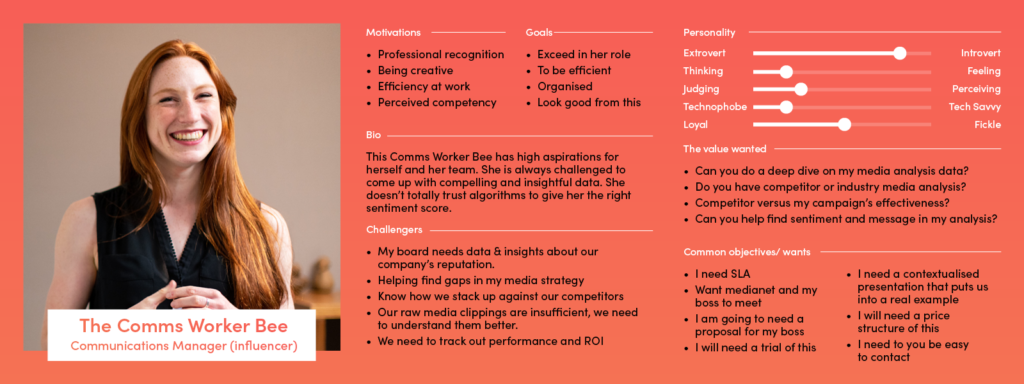

It’s tempting to dive straight into the pretty stuff when you start a business. Logos, web design, social media – all the things you use to win customers.
But the business world (and the internet) are littered with businesses gone rogue. And if you take away the fact they may or may not have had a good product or service in the first place, a lot of them can point the blame directly at having unclear objectives, a lack of customer focus, muddied messaging, and brand strategies and brand designs that miss the mark completely.
Brand strategy is not just about how you look. It lets you communicate verbally and visually with a set of values aligned to objectives that make customers more likely to remember you when it comes time to buy your thing. And it should guide your own team on how to get them there.
The strategy should be documented, and tweaked as things evolve for your business. How long it needs to be really depends on your business - for some, a one-pager can guide things to start with. But eventually you will need to expand it to ensure your brand is super effective.
In this world of insane advertising noise, being remembered for all the right reasons is vital. Here’s a checklist to help you do it.
This may sound obvious, but businesses that don’t get into the mindset early that their brand strategy needs to align with the thinking and habits of their customers often tend to focus far too much on themselves. And that leads to a dark place.
Your customers can be your true north, and can tell you where you should really go. Maybe you don’t need to change your brand strategy. Maybe you just need to give it a tweak. Maybe it needs to be binned and redone completely from scratch. You just have to ask the right questions.
The things you want to learn from them for your brand strategy are:
By asking the right questions and observing them when they’re in business mode, you start to shape a narrative about what your brand strategy needs to deliver for them, and how.
The other part of this equation is how your mission and values align with your customers. Is there a purpose or a cause driving your business? Does it truly align with the orientation of your market? Define these things as simply as possible. Long corporate values documents and wordy mission statements end up dusty or in the bin, so use it as an opportunity to keep things brief and resonant.
Choose three to five objectives you want your brand strategy to achieve, and follow the SMART objective model (Specific, Measurable, Achievable, Relevant and Timely). It’s vital these objectives are actionable for the success of your brand, and your customers.
They could look like this:
Avoid having too many (remember - A stands for achievable) and hold yourself to the deadlines you set. SMART objectives help you create a brand that focuses on the needs and wants of your category’s customers, and they build accountability into your organisation.
You can’t be everything to everyone, and nor should you. By segmenting your customers into groups who act and think in a like-minded way, you get a more focused view of who your brand strategy needs to appeal to; what your brand design, messages and content to those people should be; and how you are going to get it to them.
You don’t have to go crazy with them. Start with the segments you can clearly define – two to three segments is a good starting point but it really depends on your business.
There are plenty of ways to format them, but a useful way to ensure your business gets the most from them is like this:

Once your segments are settled, you will be able to get a better idea of how to target those segments, and test what is effective or what needs to be optimised.
Positioning is one of the absolute non-negotiables in a brand strategy. It is your opportunity to shape how you want to be known and seen in the market.
If you have done the first three parts of this well, you’ll have a great idea about how to position your business. If you want to come across as truly different in your category, look at the attributes your customers have given your competitors and position yourself away from them. If they are super corporate, maybe you can fill the more relaxed and human position. If they position themselves as the best service for medium size business, you could position yourself to appeal more to enterprise-level clients.
Or if you think you can do a better job than they can at living those attributes, position your business against theirs. For example, if your competitor’s position is “Brand A: The most service-driven XXXXX in the country”, you could position your brand as even more so. “Brand B: Service that leaves Brand A for dead”.
A strong position statement is as short as possible. It is the battle of what to leave out, and it should be the core from which all of your messaging and brand assets are derived. Some excellent examples include insurance company NRMA: Help Is Who We Are; and tech company Hubspot: Grow Better.
Yours can be longer, of course, but make sure it doesn’t dilute down the focus of your brand strategy to cover too many things. Once you have that position statement, you can start to see how you can create messaging and content from it for your category and your segments. You may even further distil it down so it can appeal to more niche segments.
And don’t forget, your brand position can help internally too. Consider it a values guide for your own staff so they are truly locked in to what you are trying to achieve with your brand strategy.
Brand assets aren’t just the logo on your company website. They can contain any number of artefacts. The important thing is it must complement your brand strategy. Use your research, objectives, segments, and position statement to decide on exactly what you need. How much you need is dependant on your objectives and the size of your company, but some must-haves to include are:
Collectively, all of these things help you attract and keep the attention of your target market. They should evoke a feeling of shared values, and speak your customers’ language.
Your brand strategy needs to go beyond how you look visually. By covering off these five strategic aspects, it can take your business to a place in your customers’ minds where they simply can’t forget you when it comes to the crucial moments of inquiring, buying and staying loyal to your brand.
And by answering these questions you can put yourself in a strategically effective position to launch campaigns faster, target your whole category and specific segments with ease, gain more sales opportunities and stay memorable for longer. You will be able to review it more effectively as your business and market evolves, and it helps keep your staff focused on the business and brand you want to be.
With a strong brand strategy, you’ll see your customers vote with their wallets. And that, after all, is crucial to any good business.
Read next: The Right Process to Follow When Designing Your New Company Logo

Article by:
Chris brings over a decade of industry experience to Red Kite working at design agencies in both the UK and Australia. Over the years he has accumulated a wealth of graphic design, strategic identity design and marketing experience. Chris is a hugely passionate identity designer endeavouring to offer the highest quality branding and logo design Brisbane and Australia wide. Chat to Chris about your branding.
We would love to hear more about your design project and how we could help bring your vision to life. Simply hit the button below to get started with a free quotation.
GET A FREE QUOTE